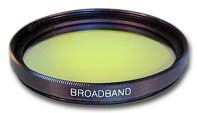By Alan Figgatt
Nebula filters are useful accessories for the seasoned observer. But many beginners or even experienced observers confuse nebula filters with light pollution filters. Common questions are: what does a nebula filter do? Should I get one? If so, should it be a narrowband or an O-III? This article, which grew out of the Sky Tour I presented at the October monthly meeting, presents a very brief overview on nebula filters.
When we refer to nebula filters, it is important to make clear that these filters are not the same as simple color filters which are used to bring out subtle features in planetary and lunar observing. Broadband and nebula filters are multilayer “interference” filters which instead filter out specific light wavelength regions as shown in the diagram.
These filters can be broken down into 3 types:
Broadband / Light Pollution
Narrowband / UHC (Ultra High Contrast)
Line: O-III (Oxygen – III), H-Beta (Hydrogen – Beta)
The diagram below shows the typical bandpass of these 3 types. This diagram presents a simplified representation of the filter bandpasses; see the diagrams from the various vendors for specifics on their filter response. The x axis is the wavelength of light across the visual range from violet (400 nm) to deep red (700 nm). The y axis is the percentage of the light that the filter passes at that wavelength. The Oxygen-III and Hydrogen –Beta & – Alpha labels mark the emission lines of oxygen and hydrogen.
Broadband filters, which are also called light pollution filters, are not considered to be nebula filters. They have a much wider passband designed to aid with deep-sky observing in moderately light-polluted skies by blocking the most common wavelengths of light pollution – that produced by low pressure sodium and mercury vapor outdoor lamps – while providing for transmission of the rest of the visual spectrum. Broadband filters can help with deep sky observing to some extent but don’t expect them to magically make the sky dark through the eyepiece of a scope. The first key point to remember about filters is that they do not make objects brighter, only dimmer! What they can do is improve contrast making an object easier to see and will often bring out more detail.
The second two types in the diagram are what are considered to be nebula filters: Narrowband and Line. Narrowband filters pass light in a region that encompasses both hydrogen-beta and oxygen-III lines. Some narrowband filters such as the Lumicon UHC and the Thousand Oaks have a hydrogen alpha bandpass while the Orion Ultrablock does not. Line filters are very narrow filters which pass a specific emission line or set of lines. The O-III filter is by far the most widely used line filter.
These filters can significantly enhance the visibility of nebulas as nebulas typically emit much of their visual light as oxygen or hydrogen emission lines. But how well they work depends on the nebula and the aperture of the scope. For some nebulas, such as the Veil Nebula in Cygnus, a narrowband or O-III filter can make a huge difference inbeing able to see it. On others, the difference is not as noticeable. Some nebulas will respond better to a narrowband while others including many planetary nebulas respond better to an O-III. For beginners, the best way to learn about using these filters is to come out to a club observing session and try one.
Because these filters can be expensive – typically $50 to $100 for a 1.25” filter or $150 to $200 for a 2” – a common question is: If I can only get one, do I get a narrowband or an O-III? You will find a difference of opinions on this. In general, if you have a smaller scope, you may be better off with a narrowband as that will pass more light. An O-III will significantly dim the view and may not be as helpful in a small scope as a narrowband. But this is not a hard and fast rule – I will use an O-III in my 85 mm refractor when looking at large nebulas such as the Veil or North American.
For anyone who has a medium to larger aperture scope and wants to hunt down planetary nebulas, an O-III becomes a must have accessory in the eyepiece case. Many observers eventually end up getting both a narrowband, if not several, and an O-III.
One other common misconception that comes up with nebula filters is that they are not needed at true dark sky sites. This misconception presumably arises from the fact that nebula and light pollution filters are frequently lumped together. In practice, a narrowband or O-III filter can be even more effective at a dark site in seeing faint details of a nebula or detecting that very hard to see planetary.
Lumicon, which was the first company to make nebula filters for the amateur astronomy market and has long been the main brand name for UHC and O-III filters, suddenly went of business at the end of September. So who are the other sources for nebula filters? There is Thousand Oaks (broadband, narrowband, O-III, H-Beta); Meade; Orion (broadband and narrowband only); Adirondack Video Astronomy which sells filters from Astronomik, a German company, which are getting high marks. Another alternative is to look for filters on www.Astromart.com, an on-line astronomy equipment classified ad site.
As I stated, this is only a brief introduction to nebula filters. For more information, there are some useful websites such as David Knisely’s review in the accessory section of www.cloudynights.com. A book that on astronomy equipment which includes a section on filters is the recently released 3rd edition of Star Ware by Phil Harrington. Another valuable resource are your fellow club members! Ask what filters they use or borrow one at club observing sessions to try it out in your scope.
End







You must be logged in to post a comment.